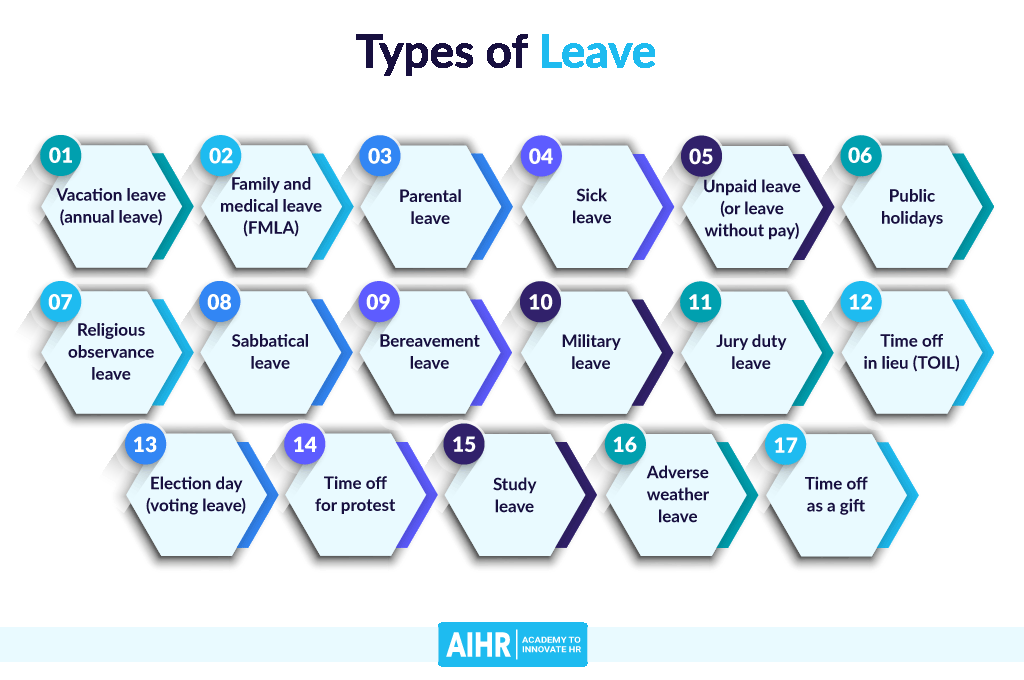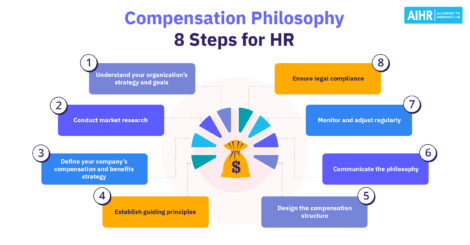17 Types of Leave HR Professionals Should Know

Organizations worldwide offer different types of paid, partially paid, and unpaid leave to employees. They are required by law to provide some of these types of leaves, and they provide others at their discretion. Having a strong understanding of these types of leave is vital to stay compliant as an organization and provide your employees with competitive benefits and a good experience when unexpected life events occur.
Here are some of the most common (and not so common) types of leave from work. We’ll discuss what HR professionals and business leaders need to be aware of. This article will focus primarily on leave in the US and cover contrasting examples from around the world.
Contents
Vacation leave (Annual leave)
Family and medical leave (FMLA)
Parental leave
Sick leave
Unpaid leave (or leave without pay)
Public holidays
Religious observance leave
Sabbatical leave
Bereavement leave
Military leave
Jury duty leave
Time off in lieu (TOIL)
Election day (Voting leave)
Time off for protests
Study leave
Adverse weather leave
Time off as a gift
Vacation leave (Annual leave)
In the US, vacation leave is not required by federal law; however, most organizations do provide employees with paid vacation leave. This also varies greatly between states. There are three main approaches to paid time off (PTO):
- Annual leave (a set number of days per year)
- Accrual bank (days are accrued monthly or quarterly)
- Unlimited PTO (an infinite number of days, which is growing in popularity as employees seek a healthier work/life balance).
In Australia, employees are entitled to a minimum of four weeks of paid leave for each year of service. Shift-workers are entitled to five weeks of leave. In Canada, employees are entitled to two weeks of paid vacation in all states (apart from employees in Saskatchewan and Federal employees who receive three). This increases in many states as the years of service do, up to a maximum of four weeks.
In Singapore, workers are only entitled to a minimum of 7 days of paid leave. There is no statutory paid leave for domestic workers, seafarers, or employees in managerial and executive positions.
Family and medical leave (FMLA)
The FMLA provides those working for companies with 50+ employees or a public agency with up to 12 weeks of unpaid leave each year. Employees must have worked for their employer for a minimum of 12 months or 1,250 hours in the past year to be eligible.
FMLA leave applies in several cases, including:
- The birth and care of an employee’s newborn child,
- Caring for an immediate family member with a serious health condition, and
- Taking medical leave if they are unable to work due to a serious medical condition of their own.
Parental leave
Parental leave is sometimes divided into maternity and paternity leave. However, organizations are gradually replacing this with the more inclusive term of parental leave for all.
Many employers across many states are not legally required to offer paid maternity leave, but the FMLA does grant every woman the right to take up to 12 weeks of unpaid leave for this reason (including adoption). Only eight states in the US offer fathers and mothers partially paid parental leave (California, New York, New Jersey, Washington, Rhode Island, Oregon, Massachusetts, and Connecticut).
Some European countries are far more generous regarding maternity leave. In particular, Estonia grants female employees the right to stay at home and look after their newborn child, fully paid for up to 18 months. Meanwhile, Japan offers new fathers up to 30 weeks of paid parental leave equivalent to their salary rate.
Sick leave
Federal law does not entitle employees to paid sick leave; however, the FMLA offers many employees unpaid time off due to health concerns. Many organizations across the US choose to provide paid sick leave to employees. They do it either by allotting a specific number of entitled days or offering an umbrella PTO policy.
In contrast, many countries across Europe, Asia, and South America offer mandatory paid sick leave. An extreme example is the Netherlands, where employees recovering from a disease can be off work for up to 24 months while still receiving a minimum of 70% of their salary for this period.
Unpaid leave (or leave without pay)
Employees may wish to (or need to) take unpaid leave for various reasons should they not have enough paid leave days to use or if unexpected events occur in their personal life. However, there is minimal federal regulation regarding unpaid leave (outside of the FMLA). It means it’s up to individual organizations to set their own rules and treat each scenario on a case-by-case basis.
Public holidays
Many organizations across the US will provide employees with a set number of paid holidays as part of their compensation and benefits package. However, this is less likely to apply to hourly and part-time workers. Some of the most common paid holidays are Thanksgiving Day, Christmas Day, Independence Day, and New Year’s Day. The final list of included holidays varies between organizations. Reports show that 97% of companies offer paid leave for Thanksgiving Day, although there is no legal requirement for them to do so.
Some organizations offer employees a set number of “floating holidays” in addition to their PTO, which entitles them to a set number of paid days off as a substitution for a public holiday.
In Singapore, employees are entitled to paid leave for 11 of their public holidays. If an employee does have to work through one of these holidays for whatever reason, they are usually compensated with double-pay or a day of time off in lieu (TOIL). We discuss this type of leave below.
Religious observance leave
Religious observance leave is generally unpaid leave granted to employees who wish to participate in various religious festivals, traditions, or celebrations that are not recognized as public holidays. For example, in the state of Victoria, Australia, those practicing under the Jewish faith can receive up to 13 days off for religious observance.
It’s important to mention that in most cases, these employees are required to provide some form of evidence of their faith to have their religious observance leave approved.
Sabbatical leave
Sabbatical leave was originally coined in educational institutions to grant employees extended periods off (for personal reasons, research, or study) while remaining employed. Today, sabbatical leave is one of the growing types of unconventional leave. A report by SHRM found that in 2018, 10% of organizations offered employees unpaid sabbatical leave while 5% offered paid ones.
Bereavement leave
An employee takes bereavement leave or funeral leave after the death of a loved one (usually a relative or close friend). This would typically be as long as the employee needs to attend the funeral and recover from immediate grief. It is sometimes confused with compassionate leave, which includes taking time off to look after a sick relative or someone dependent on you.
Bereavement leave is not mandatory by law in the US. However, some organizations do have an internal policy in place for this while others allow it as and when required. In most cases, employees will only qualify for bereavement leave if they are full-time workers and have been with the company for a set period. In Canada, employees are eligible for paid bereavement leave if they have completed three months of employment at the organization.
Military leave
Those undertaking select types of active or inactive duty in the National Guard or acting as a Reserve in the Armed Forces are entitled to fully paid leave. The Uniformed Services Employment and Reemployment Rights Act was also set in place to ensure that employers provide reemployment to those who take on active military duty and National Guard Services.
Different types of military leave are provided depending on the sector and length of absence.
Jury duty leave
The National Center for State Courts (NCSC) estimates that 32 million people get summoned for jury service every year. 1.5 million of those are selected to serve. There is no Federal law that states employers must pay employees for leave due to jury duty, although certain states require this of their organizations.
Employees must be granted time off to serve on juries in the UK. Although no law requires staff to be paid, many employers will do so.
Time off in lieu (TOIL)
Time off in lieu (TOIL) is a compensation policy put in place by many organizations. A set period of overtime hours worked can be taken as extra leave time instead of the employee receiving additional pay. For example, if an employee were contracted to work 40 hours per week but worked 45, they would be entitled to claim an extra five hours off “in lieu.”
Organizations with TOIL systems in place tend to have employees who feel more positively about doing overtime, resulting in higher productivity. This is also a great way to fairly compensate employees without putting a company under financial pressure.
Election day (Voting leave)
Voting leave refers to time off on official election days to ensure everyone has an equal opportunity to participate. While Federal law doesn’t state that employers have to provide paid or unpaid leave for employees to vote, states vary in their regulations. Many states (including California and New York) require employers to pay for a minimum of an hour of their employees’ voting time.
However, polls are generally open across the US from around 7 AM through to 8 PM. This allows the majority of workers to vote outside of their set working hours.
Time off for protests
In the more democratic states of America (including San Francisco, California, and New York), it’s common practice for people to oppose government laws and decisions. Therefore, when a big protest occurs, an employee may wish to take leave from work to demonstrate their support and rally for what they believe in. Many organizations in Silicon Valley have included time off for protests in their standard employee benefits.
Study leave
Study leave refers to when an employee wants to further their education, either through formal routes like attending university or acquiring new skills in another way. Although this type of leave is not included in many organizations’ benefits, it is generally granted on a case-by-case basis at the employer’s discretion.
If the employee can demonstrate how their new skills will benefit them at work and therefore help the company, they are more likely to be granted study leave.
Adverse weather leave
Certain weather conditions make it extremely difficult, dangerous, and sometimes impossible for employees to travel to work. Such conditions include heavy snow, a hurricane, or flash flooding. During these adverse conditions, many employees will need to take time off. If the employee has paid leave left to take, they will often be allowed to take this time off as part of their annual leave.
In some organizations, employees are granted days off (a maximum of 60 to 90 days) but are required to make up that time at a later date. They are required to submit a formal letter—known as an Adverse Weather Leave Letter—requesting the leave and stating the kind of adverse weather condition it’s attributed to.
Time off as a gift
Finally, some organizations grant employees time off as a gift in special circumstances. For example, if an employee gets married or has a baby in Japan, their organization will often gift them with unpaid time off. This is not a legal requirement in Japan but a long-standing custom to show respect and appreciation to workers.
Other types of leave
There are also other types of leave that your HR department might choose to include in your leave policy, such as:
- ADA leave
- Temporary disability leave / short-term disability leave
- Volunteer time off
- Leave to appear as a witness in court
- Emergency leave
Bear in mind that standard and required types of leave will differ per country and/or state.
Over to you
HR professionals and business leaders need to be aware of many different types of leave of absence. That way, they’re able to ensure employees feel valued and secure in their job. When creating your policy, it’s essential to consider and include all relevant types of leave. It will help your organization remain compliant and competitive in an ever-evolving landscape.
Weekly update
Stay up-to-date with the latest news, trends, and resources in HR
Learn more
Related articles
Are you ready for the future of HR?
Learn modern and relevant HR skills, online












